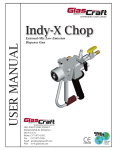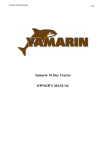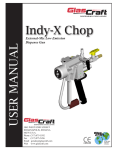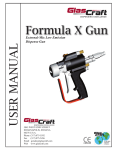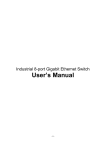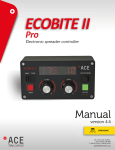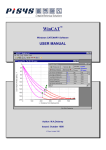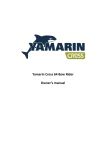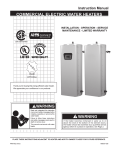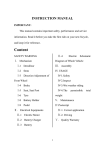Download STM 4700 SportFun USER MANUAL
Transcript
STM 4700 SportFun 1 (31) STM 4700 SportFun USER MANUAL STM 4700 SportFun 2 (31) FOREWORD Dear Owner! Congratulations, you have made perfect choice purchasing this catamaran. This Manual will help you to learn the specific features of the boat, how to use it, carry out maintenance, and drive it to avoid unnecessary problems in during of your nautical explorations. Please make sure that at the time of purchase you have received manuals to all additional equipment mounted on your boat. Keep the manuals in a safe place where you can easily reach them when necessary. Read all sections of this Manual carefully before you launch the catamaran and start to use it. In case this is your first boat or you have changed a one-hull boat to a catamaran for the first time, please make sure you have sufficient knowledge to control your boat on the water. This is important for your personal safety and that of other boaters. National and local boat clubs and societies will help you in the search of professional advice and training as well as in obtaining necessary certificates and permissions. Before sailing check weather conditions and the forecast and make sure your catamaran is qualified for the weather, and you are able to control of it. Catamaran ratings A, B, and C (European Standards) correspond to certain wind and water surface conditions. The catamaran is designed to withstand the rated loading, but you have to keep in mind that in a storm sudden high waves (especially over shoals) and wind gusts are quite possible which will heighten the load on the boat. To weather these conditions a competent crew and a sound boat are required. NB! This Manual IS NOT a course in navigation and can not replace proper training. This Manual is not a repair manual as well. In case of discovering technical problems please contact the manufacturer or the dealer. Please allow only skilled professionals to carry out maintenance works on your vessel. In case any changes to the construction or modernization has NOT been done by the manufacturer, the latter has responsibility for the consequences only in case all changes have been approved by the manufacturer in writing, and recommended engineering techniques were followed. In some countries you have to obtain a license to drive a boat; requirements change from country to country. Please familiarize with and comply to them. Maintain the catamaran in good technical condition, regularly check for tear and wear signs, as well as for damages that may be caused by overload or inappropriate operation. Any boat irrespective of her strength and age can be damaged by incompetent exploitation which may cause serious danger at sea. Always adjust speed and the direction to waves with the weather conditions. Personal safety equipment (life jackets, safety halyards, heaving line, life buoy, fire extinguisher, etc.) should be always present on board in sufficient quantity according to the number of the crew and passengers. National safety requirements should be strictly complied to. All present on board should be familiarized with the safety equipment and safety procedures (rescue operations, haulage, etc.) All crew and passengers should use lifejackets fitting their weight; note that in some countries sailors should wear lifejackets at all times when on board. Oy STM-boats Ltd, Toikkalantie 515, 53100 Lappeenranta STM 4700 SportFun 3 (31) Contents 1 General 6 Warnings 6 2 Warranty 6 3 Before Launch 6 3.1 Registration 3.2 Insurance 6 6 4 Catamaran Characteristics 7 4.1 General 4.2 Basic Particulars 7 7 Technical specification 4.3 4.4 4.5 4.6 4.7 4.8 4.9 4.10 Maximum recommended number of persons on board Loading Engine and propeller Preventing water entry in the hulls; floatability and stability 4.6.1 Hull and deck openings 4.6.2 Stability and buoyancy Prevention of fire/explosion 4.7.1 Refueling 4.7.2 Fire prevention Master switch At Sea 4.9.1 Controls 4.9.2 Dead man's grip 4.9.3 Gas and reverse 4.9.4 Engine Trim 4.9.5 Engine Start 4.9.6 Driving 4.9.7 Berthing 4.9.8 Tent Good seamanship - other recommendations and instructions 4.10.1 Falling overboard: "do"s and "don't"s 4.10.2 Load fastening 4.10.3 Preservation of the environment 4.10.4 Mooring and anchoring 4.10.5 Towing 4.10.6 Trailer towing 4.10.7 Winter Storage 5 Maintenance 5.1 Hull Washing 5.2 Seats Care 8 10 11 11 11 11 13 13 13 14 15 15 16 16 16 16 17 17 18 19 19 19 20 20 20 21 22 24 24 25 25 STM 4700 SportFun 5.3 5.4 5.5 5.6 5.7 5.8 Tent Care Windscreen Care Engine Control Care Steering Gear Care Electric System Care Minor surface damage 6 Winter Storage 6.1 Before Winter Storage 6.2 Before Spring Launch 7 Systems and Devices 7.1 7.2 7.3 7.4 General View Fuel Piping Steering Electrical System 4 (31) 25 25 26 26 26 26 27 27 27 29 29 29 30 30 STM 4700 SportFun 5 (31) BEFORE GOING OUT Please read this Manual carefully. Check the following: Weather conditions and forecast Consider strength of wind, wave height and visibility. Do the size and class of the catamaran as well as the crew training and experience correspond to the weather conditions you are about to sail in? In strong wind and at choppy sea make sure all hatches are battened down to prevent water ingress inside the hulls. − Load Do not overload the catamaran and distribute it evenly. Remember: heavier things should be positioned lower to keep the boat stable. The catamaran's stability is normally higher than that of a one-hull boat, but it should be considered nevertheless. − Passengers Make sure you have lifejackets of proper size for every crew member and passenger. Explain their responsibilities before sailing. − Fuel Check the fuel level in the tank; remember to keep at least a 20% reserve for the passage in case of rough weather. − Engine and steering controls Check controls, battery and electric system. Make sure the motor starts and the emergency switch works properly. Make sure the pipelines and joints do not leak. Open rear seats hatches and make sure there is only a minimum of bilge water in both hulls. − Hull and bilge pump system Check the hull condition, start/stop bilge pumps, make sure they operate properly, check holds on both sides. − Fuel tank compartment ventilation Make sure the scuppers in the rear part of the console are free, vents are air-passable; it is necessary for the fuel spilled can be freely blown away. − Load propping and distribution Check the load placement and fastening: even at rough seas it should remain in place. − Nautical charts and navigation Please do not forget nautical charts and/or chart plotter with digital charts if you are not absolutely sure of your knowledge of the passage. − Sailing Let the crew members know their actions sequence beforehand. All moorings should be tidied to prevent them from going under the propeller. − Compulsory equipment According to the water code every boat should have on board the following equipment in proper condition: − 1) Standard-complying lifejacket, life vest or overalls for every person on board. These should correspond to the person's height and weight. 2) Bilge pump or bucket. 3) Oars or anchor with anchor line. 4) Standard-complying fire extinguisher at least 2 kg, if the motor capacity is more than 25 kW (34 h.p.). The fire extinguisher should be filled and its use-by date is not expired. The outboard engine check instructions you will find in the engine Manual. STM 4700 SportFun 1 6 (31) General Warnings The warnings in this Manual are marked as follows: DANGER! WARNING! ATTENTION! Indicates danger which will lead to a high probability of death or serious injury if appropriate rescue measures are not taken immediately. Indicates danger which may lead to injury or death if appropriate precautionary measures are not taken. Is a reminder to operate according to safety rules or of dangerous methods of operation that may lead to injury or damage to the catamaran or its parts. If necessary comments are given in brackets. The wind speed is designated in the Beaufort scale according to the EU Directive on recreational craft 2 Warranty A one-year guarantee is provided for the catamaran and additional equipment installed in the boatyard. For the engine, instruments and other devices, the respective manufacturer of the equipment is responsible for any warranty concerns. In case of an insured accident please contact the dealer indicated you have purchased the boat from. Kindly provide the catamaran model and its serial number. 3 3.1 Before Launch Registration It is mandatory (in Finland) for all boats equipped with either an outboard engine with a capacity more than 20 h.p. or fixed engine with a capacity more than 50 h.p. to be registered. Check with the local authorities regarding details. Only persons above 15 years old are allowed to drive a registered boat. 3.2 Insurance Boat insurance may compensate for damage that has occurred on the water or when dry docking. The insurance has an important effect on safety on water: in an emergency you can concentrate first of all on saving lives, not the boat. The insurance company will provide more detailed information on the insurance possibilities. Check separately the insurer liability when hoisting the boat or during transportation. STM 4700 SportFun 4 4.1 7 (31) Catamaran Characteristics General This Manual is neither a navigation manual nor repair guide; its aim is to help you learning the characteristic features of the catamaran use. 4.2 Basic Particulars Manufacturer: Oy STM-boats Ltd, Toikkalantie 515, 53100 Lappeenranta Notes to Technical Specification Design categories: ABCD The letter indices are defined as follows: Category A: The boat is designed for operation in conditions whereby the wind velocity is more than 8 on the Beaufort scale (above 21 m/sec) with a higher than 4 m (see notes below). The vessel should be safety-independent. This category does not cover catastrophic conditions, such as hurricanes, etc. Such circumstances can be met with in the far travels, when crossing the ocean or navigating along the coast with heavy seas during hundreds of miles. Category B: The boat is designed for operation in conditions whereby the wind velocity is at most 8 on the Beaufort scale (below 21 m/sec) with a swell up to 4 m (see notes below). Such circumstances can be met with in the open seas, when navigating along the coast on the passages of tens of miles, and also in big lakes prone to generating big waves. Category C: The boat is designed for operation in conditions whereby the wind velocity is at most 6 on the Beaufort scale (below 14 m/sec) with a swell up to 2 m (see notes below). Such circumstances can be met with in the open lakes, in estuaries of big rivers, and in coastal waters under moderate weather conditions. Category D: The boat is designed for operation in conditions whereby the wind velocity is at most 4 on the Beaufort scale (below 8m/sec) with a swell up to 0,3 meters, with occasional large waves of up to 0,5 m high. Such conditions can be met in sheltered inland waterways and in coastal waters in good weather. Note: the maximum wave height notion is used for design purposes. In practice, the average height value of the upper third of the swell is considered. If the maximum swell height is 2,0 m, the average то wave height will be around 1,2 m. Maximum allowed load: The maximum weight of equipment, etc. which should not be exceeded. See also paragraph 4.4, Loading Main dimensions and capacities: The length, breadth, depth, gross weight, tank capacities, etc.; see technical specifications. STM 4700 SportFun 8 (31) Scope of catamaran use: See design category. Bear it in mind when taking decisions. Manufacturer’s plate: Part of the above information is recorded on the manufacturer’s plate which is attached in the rear part of the cockpit, on the right side. Complete explanations are given in the appropriate sections of this Manual Technical specification Model Design Category Hull length Max. beam Weight, unloaded (without engine) STM 4700 SportFun C 4.70 m * without outboard engine 2,10 m 469 kg Max. number of persons Max. load/Max. number of persons Max. load CE-plate Max. recommended engine output 7 525kg/ 7 + baggage 10kg + fuel 30kg 525kg 52 kW/70 p.h. Max. engine weight (CE-standard) Fuel tank capacity Construction material Colors: - hull - deck - console and seats lids Water line: - on transom - on sterns Steering bowden Gas and reversal bowdens 160kg 30 ltr (a portable tank) glass-fiber White White or light grey White or light grey 110 mm 1120 mm 3,50m 2,50m Waterline example. STM 4700 SportFun 9 (31) Standart equipment Fiber glass hull Rubber fender guard with terminator Steering console with plastic hatch 370 х 375 mm Mooring cleat Trailer eye Hand rail Plastic hatch for forepeak 370 x 375 mm Aft covers with locks and hinge Bow cover with locks and hinge Steering console cover with locks and hinge Seats Inspection hatch 180 mm ABS Rubber gland for wiring Rubber gland for steering bowden Drain fitting Drain fitting stopcock 1 ½” L-drain fitting Drain plug Drain system hose 1 ½” 450 mm Air gate (console) 92x92 mm Accumulator box Recess drain fitting Forepeack locker Bow locker Steering actuator Steering bowden Steering wheel Fuel tank 23 l Ladder 1 1 1 4 3 5 1 2 1 1 2 1 4 1 2 2 2 2 2 2 1 1 1 1 1 1 1 1 (2) 1 Accessories Bilge pump Piranha 12 v 1440 l/h Drain fitting for bilge pump 19 mm Drain system hose ¾”, 1100 мм Mast for navigation light (white) 12 v Master switch 12 v 500 A Connectors for accumulator clamps 12 v Switch panel with fuse (3 or 5) 12 v Block terminal 12 v Waterproof box for blocks terminal Fixed fuel tank (45 или 65 l) Fuel level detector 12 v Fuel level gage 12 v Plug and socket 12 v SeaLink Wind screen with fence Running tent Targa with towing hook 4 - blade propeller (steel or aluminium) 2 2 2 1 1 2 1 2 1 1 1 1 1 1 1 1 1 STM 4700 SportFun 10 (31) Navigating devices, means of safety, communication facility, audio-system and the other equipment it is delivered together with a catamaran after discussion with the customer. 4.3 Maximum recommended number of persons on board The maximum recommended number of persons on board of your catamaran is shown in the technical specification. See attached diagrams. Maximum number of passengers seating arrangements Shading designates a zone allowed for accommodation of passengers WARNING! Do not exceed the maximum recommended number of persons on board. Irrespective of the number of people on board the total weight of persons and equipment must never exceed the maximum recommended load (see paragraph 4.4, Loading). Use only the catamaran’s seats, standing in the cockpit during sale affects the boat's stability and safety of people onboard. WARNING! Catamaran's better stability (comparing to one-hull boats) notwithstanding, do use seats! Remember, the water surface is not stable in itself. Your catamaran is capable of very sharp a turn which causes powerful centrifugal acceleration, which in its turn may cause falling on the deck or overboard. Do not be lulled by the catamaran's usual stability and be alert. WARNING! Coming out on the bow deck is allowed at berthing only when the engine is switched off! Never allow passengers to stand or seat there when navigating! The area is for mooring and loading/unloading convenience only! Falling into the water from this spot is extremely dangerous because of the engine propeller. With the boat length of 5 meters and speed of 10 km/h you will not have the time for emergency stop. Pay special attention to children who are prone to play anywhere and underestimate danger! STM 4700 SportFun 4.4 11 (31) Loading To estimate the actual load consider the following (According to standard ISO 14946 maximal load for STM 4700 SportFun - 565 kg, on CE-plate the manufacturer is noted loading 525 kg): a) Quantity the person onboard (weight of the average adult 75 kg, the average child 37.5 kg). The total weight being onboard should not exceed 525 kg b) Weight of other naval stores - 10 kg. The obligatory naval stores are listed in your ship ticket, count up and remember its weight! c) Weight of fuel in the portable fuel tank - 30 kg. *According to standard ISO 14946 maximal allowed loading includes only the above described components. Sample calculation: Allowed load for STM 4700 SportFun = 525kg Totally on board the catamaran are 4 adults, 2 children, 20 kg of water, 15 kg of sport equipment and 15 kg of basic equipment. 4*75kg + 2*37,5kg + 20kg + 15kg + 15kg = 420kg Total weight (420 kg) does not exceed the allowed maximum load (525 kg), so the boat is not overloaded. WARNING! 4.5 When loading your boat never exceed the maximum recommended load. Load the catamaran carefully and distribute the load properly so as to maintain the design trim. This will add not only to safety, but also to the performance. Avoid storing heavy weights at heights from which they would be likely to fall. Engine and propeller The largest recommended engine capacity for the catamaran is shown on the manufacturer's plate and in technical specification. Please comply with the engine manufacturer's instructions. The maximal allowed power of engine - 52kW/ 70л.с. The maximal weight of engine – 160 kg 4.6 4.6.1 Preventing water entry in the hulls; floatability and stability Hull and deck openings The STM 4700 SportFun catamaran has a self-draining cockpit: a system of drains and openings allows the rain water to flow overboard by itself if the catamaran has a different to aft, and the outlets are free from debris. The outlet's outboard socket is fitted with a valve which allows stopping water from flowing into the cockpit if the outlet pipe is damaged or comes off the fitting. The valve is accessed through the rear seats lids. STM 4700 SportFun 12 (31) Water is removed from the cockpit through these outlets both when sailing and when moored. The cockpit height over water level is about 100 mm (depending on the load). The cockpit bottom is sealed up to the back seats. The forward locker and the locker under the front transverse seat are also sealed and have no openings to the hull. The driver's console is not tight, but its compartments are not communicated with a cavity of the hull. The back compartment has a scupper hole and a ventilating hole for prevention to filling a vapor of gasoline. Its drainage is carried out in a cockpit. The rear seats lids (giving access to the outlet valves and bilge pumps) are sealed with rubber gaskets and do not completely prevent water from entering the hull. Drain plugs on the transom on the keel level must always be plugged when boarding! Unplug them for draining and ventilating the hulls when the catamaran is docked. Your vessel should have a bilge pump. It can be the hand-operated pump or electric pump (by request). The electric bilge pumps (one in each hull) that could be started by switches on the switchboard. WARNING! WARNING! The bilge pump is not intended for removal of water at presence of a shellhole (leak) in the hull. The owner of a catamaran necessarily SHOULD have at each output on water a scoop, either a bucket, or a manual pump for removal of water. Their presence on a catamaran to be on the responsibility of the owner (user). Their presence should be checked before each output on water. Location of outlets and bilge pumps WARNING! Learn in details how the hulls draining system works before sailing, this will allow you to react fast in case of emergency. STM 4700 SportFun 13 (31) ATTENTION! Keep the outlets clean from debris which may prevent normal flow of draining water. This may cause hull flooding. In cold weather ice in fittings may prevent draining. ATTENTION! There is always some condensate in the hulls. With time fittings may start to let some dripping water inside. Remember to check the bilge level before going to seas and upon return to the moorings. WARNING! The catamaran's buoyancy and course-keeping qualities may drastically change due to flooding of hulls, this may present danger to the crew and passengers. Regularly check the drain openings and bilge pumps before sailing. Ability of a catamaran to keep on water and controllability can considerably will change at flooding underdeck space, it can be fatally dangerous to passengers. Watch draining system of a catamaran and check its accuracy at each output on water. WARNING! WARNING! At bad weather and a strong wind close all hatches and covers to prevent water fill up. WARNING! Breaking crests of waves represent greater danger to stability of your vessel. The catamaran even completely filled by water keeps afloat all crew in conformity with regular maximal loading 565 kg. 4.6.2 Stability and buoyancy The higher the catamaran center of gravity, the worse its stability. Normally, catamaran's stability is higher compared to one-hull boats, but be alert nevertheless! Your boat course-keeping qualities and fuel-saving capacity may be affected by overload and ineffective load distribution. WARNING! WARNING! 4.7 4.7.1 Any changes in distribution of weights and their heights can influence stability, a running trim and a propulsion quality of a catamaran. (For example, at installation of arches, fishing racks, towing racks, heavier engine, self-made cabins, etc.) At increase of the centre of gravity of a catamaran due to put up of greater cargoes on significant height, stability can change up to dangerous value Prevention of fire/explosion Refueling Before refueling turn the engine off; do not smoke. Do not use anything (including switches) capable of producing sparks. When refueling at a service station, do not use plastic funnels that prevent the discharge of static electricity between the filler pistol and the bushing of the fuel inlet. After filling the tank check that no fuel has been spilled. Immediately wipe off any fuel splashes. The catamaran maybe supplied with a fixed fuel tank (by request) under the hatch of the driver's console STM 4700 SportFun 14 (31) which allows visual control at refueling. If your catamaran is completed with a mobile tank (standard equipment) it must be lifted out of the boat in order that to fill it to prevent fuel spilling. Make sure the main plug and the drain plug are properly fixed before lowering the tank into the fuel compartment. Make sure the tank is properly fixed inside the compartment. Do no put additional canisters containing fuel neither into the forward console compartment nor to the compartment under the rear seats. Fuel evaporation in an unventilated space may cause explosion! Do not store anything but the fuel tank in the tank compartment! This may cause fuel piping damage, fuel leak and create the danger of fire or explosion. Annually check that there has been no wear and tear in the fuel feed pipes. All damaged parts of the fuel piping or equipment should be replaced immediately by new standard-complying spares. WARNING! Fuel vapors are highly explosive. Confirm to safety rules when refueling! Fuel smell is a sign of the fuel evaporating, being spilled, or of a fuel piping leak. 4.7.2 Fire prevention There should be on the STM 4700 SpotrFun catamaran a hand-held fire extinguisher at least of 8A68B capacity, if the engine capacity is more than 25 kW (34 hp). Below indicates the fire extinguisher location. The fire extinguisher location The fire extinguisher should be serviced annually. After 10 years it can not be used without the pressure proof. Buying a new extinguisher make sure it is with an extinguishing capacity at least the same as the one being replaced. Make sure the fire extinguisher is easily accessible when the catamaran is fully loaded. Notify all crew members and passengers of the location and method of operation of fire extinguishing equipment. Keep the bilge clear and regularly check for possible fuel leaks. WARNING! Do not alter and do not change onboard systems of a catamaran (especially the electro-scheme and fuel system), do not allow not qualified people to intervention in the established equipment and onboard systems of a STM 4700 SportFun 15 (31) catamaran. 4.8 Master switch The master switch (does not including into the basic complete set, install as the additional equipment, look enclosed in the end of the user manual the electroscheme). If you order electric devices you should order also the master switch. The master switch is located in the forward compartment of the console : - clockwise turn > connects the accumulator to the circuit - counter-clockwise turn > disconnects the accumulator from the circuit Leaving the catamaran always disconnect the accumulator from the circuit. ATTENTION! Never turn the accumulator off with the engine running, this may cause damage the generator! WARNING! The onboard electro-system can cause explosion or ignition fuel vapor at misuse of electro-system. Closely read and consider the following: The electro-scheme of a catamaran (does not include into the basic complete set) includ an automatic fuses, installation of the additional equipment around or without fuses it is prohibited. The fuses turn on by pressing of the button near to the switch. At all be not installing the additional equipment at alive. At all do not allow to installing additional equipment the not qualified people, the naval expert of electrician and electronics should do it only. At all do not stop up ventilation hole on the steering console (in an aft part for a fuel tank and a bow for the accumulator). At all do not use additional electric equipment on the capacity exceeding values of fuse and wiring. At all do not replace elements of the electro-scheme (especially fuses) with more powerful. At charge the accumulator separately from onboard system disconnect plugs of power wires 4.9 At Sea In case this is your first boat or you have never used this type of boat before, engage with you for the first trip someone having experience with this type of boat. WARNING! Do not use a catamaran if its engine more powerful than specified in the specification. Do not use negative trim of engine (pressing a leg of engine to transom which lowers a bow of a catamaran downwards) for continuous movement with full speed because at sharp turns it can lead to loss of stability of movement. This position of engine is used only for acceleration boat planning. This position maybe use for moving with low speed on a wave. At all do not moving with the big speed on navigable waterway, narrowness and at restriction of visibility because of time of day or weather conditions. STM 4700 SportFun 16 (31) Reduce speed and a wave at passage by other small boats, it raises safety for associates. Pay attention to requirements and signs on reduction of speed and prohibition of creation a wave. Always keep sufficient for braking and stopping a distance for prevention collisions. Visibility at the driver can be limited at lowers a bow of a catamaran upwards at the slowed down planning progress. Operate trim button of engine correctly, use negative trim of engine for acceleration of planning progress. Do not use long movement in a not planning mode with high lifting bow of a catamaran. WARNING! WARNING! 4.9.1 Controls The catamaran is very easy to control – partly due to its heightened dynamic stability. You can easily master the basics of navigation but remember that changing weather conditions could be a challenge even for an experienced sailor. The catamaran is fitted with the cable controls (steering wheel and steering bowden). The outboard engine control stick contains gas control (accelerator) and motion (forward – neutral – reverse), and the engine trim control button. 4.9.2 Dead man's grip It is an emergency cut-off device, a line attached to the ignition breaker and the pilot's life-jacket. The engine stops if the line tug removes the breaker from its slot. It is very important that the boat stops if for some reason you fall overboard or stumble on board. It may happen in case of grounding, stumbling on a floating obstacle, falling overboard during storm, etc. Never drive the catamaran without the deadman's grip attached to your life-jacket. If you prefer to attach it to your wrist, never drive with this hand since the line may get tangled in the steering wheel at sharp turns. The engine would not start until the breaker is not inserted. DANGER! 4.9.3 A rotating propeller is highly dangerous to anyone who has fallen overboard or to a swimmer. Use the dead-man's grip to switch off the engine until the swimmer or water skier gets on board. Gas and reverse To shift into forward press the locking pushbutton on the underside of the engine control stick and move it forward; or move it back to shift into reverse. The same stick controls speed. Use the reverse to reduce speed on slow speed only, i.e. approaching the berth. An attempt to do it on high speed may cause damage to the engine. 4.9.4 Engine Trim Here below are the basic rules of adjusting the engine trim: STM 4700 SportFun - - 17 (31) when raising the boat to plane trim the engine to the transom (negative angle), the bow will also go down When the catamaran is planning, rise the engine until the propeller begin to cut air – this is the trim upper limit. Lower the engine until the propeller works stable – this is the optimum angle. If the load changes use the trim control to adjust the angle to obtain an optimum. When the engine power trim is at a negative angle, i.e. with the bow low you would not be able to reach maximum speed. A catamaran with optimum load distribution carrying a crew of two planes best with the trimmer position "right in the middle" In a counter swell, lower the bow when the impact is too high; usually it is not necessary with the wave height up to 1 m In a favorable swell raise the bow slightly so that it does not dive. This recommendation is valid for the sea, but on the short lake waves with small waves spacing it will not be necessary. See also the instruction manual for the engine. 4.9.5 Engine Start 1. Using main switch connect the accumulator to the circuit. 2. Lower the propeller into the water using the Engine Trim button on the control stick. 3. Pump some petrol using the hand-operated petrol pump (on the fuel pipe in the under-engine recess), squeeze it until it becomes hard. 4. Make sure the control stick is in "neutral" position, and the dead-man's grip is connected to it. 5. Connect the circuit to function by turning the key and wait the control lights to light up. 6. Start the engine by turning the ignition key clockwise. 7. Use the choke if necessary, on most engines it is controlled by separate lever on the control stick. Many engines now feature automatic choke-on at start. 8. After start let the engine to idle for some time before sailing. See for details the engine handbook. 4.9.6 Driving In favorable weather conditions driving is nice and easy. Always make sure you have sufficient view of the surroundings from behind the steering wheel which is in accordance with the COLREG rules. - Place the passengers so that they do not impede your field of vision Take the catamaran to plane as fast as possible so that the raising bow does not limit visibility In bad weather look over the windshield splashed by water Remember also to look astern in case of approaching vessels, particularly in shipping lanes; remember that a large vessel has less maneuverability than your catamaran On the approach of darkness use the appropriate navigation lights. Learn the rules of navigation and follow them. Observe the requirements of COLREG (Convention on the International Regulations for Preventing Collisions at Sea). Use updated navigational charts. Adjust your speed in accordance with weather conditions and situation. Take into consideration: - wave (ask your passengers for their opinions on a comfortable speed) STM 4700 SportFun - 18 (31) your wake (greater when rising to plane, smaller at displacement speed, i.e. below 5; your catamaran creates lower wake comparing to the one-hull boats of similar size) visibility (islands, fog, rain, blinding sunlight) knowledge of the route (time required for the passage) narrowness of the route (other traffic in the waterway, noise, and the effect of backwash on the shoreline) Driving the planning catamaran at low speed reduces controllability. Be careful in narrow passages and passing approaching traffic. The catamaran's trim and heel affect controllability and fuel consumption. The trim and heel may be changed by: - load distribution. Do not overload bow and aft. - engine trim control. Optimum trim makes for stability in swell which adds both to safety and comfort of passengers. WARNING! Controllability at high speed is diminished. Rapid turns can lead to loss of control, causing the catamaran to heel. 4.9.7 Berthing Practice mooring and anchoring in good conditions with sufficient room for maneuver before entering narrow marinas for the first time. Too little gas at slow speed may not give enough moment for the correct movement. Use engine power in powerful but short bursts. Make sure all passengers but those who help you berthing safely sit during the approach. Sudden jerks during maneuvers may cause falling. Before berthing get bow and stern mooring lines ready. Approach the berth at a small angle, bow forward. At close distance to the berth use reverse to reduce speed. Use the engine gas control in short powerful bursts. When mooring to a guest wharf choose a place with the head wind or tide (whichever is more powerful is better), this will facilitate sailing (the tide and/or wind will move the catamaran from the wharf). Pressing tide and/or wind will require more power to pull away from the wharf and maneuver. When sailing first push the aft as far from the wharf as possible, then at medium speed drive to clear space to maneuver and turn. The engine propeller is designed to create more propulsive force at forward motion. In the reverse it has lesser power, which means the catamaran is less controllable at the reverse motion. Besides, at low speed the propeller reactionary torque is more pronounced, i.e. at shifting to neutral and placing the steering wheel in midposition the motion will not be a straight-line. WARNING! Your catamaran is a high-speed craft, she cannot stop at once; reduce speed in advance when approaching a wharf or shore, learn to estimate the required stopping distance. Bear in mind: the catamaran is less controllable when in neutral, even if it still moves. STM 4700 SportFun 19 (31) WARNING! Do not try to stop the boat’s motion by using your hand or placing your hand or foot between the boat and the jetty, the shore or another boat. Practice mooring and anchoring in good conditions and use engine power with restraint but resolutely. ATTENTION! When mooring your boat, always bear in mind wind change, tidal effects, backwash from other boats etc. Further information can be had e.g. from your insurance company. 4.9.8 Tent The tent is delivered with a vessel under the special order. You can use the tent in different ways. It is possible to use its forward part only; its roof and side parts only; or the whole tent. Roll and fold the tent carefully. The tent is designed for speeds no more than 25 knots (approximately 45 km/h) with all zippers and lashings fastened. Take it into consideration when preparing for trailer towing (it is better to trailer-tow the catamaran with the tent on). The tent also increases windage which will affect the controllability of the catamaran. 4.10 Good seamanship - other recommendations and instructions 4.10.1 Falling overboard: "do"s and "don't"s Man overboard is a critical situation. Train to approach a person in the water in good weather. The approaching a person in the water is most difficult in choppy sea. You should approach so that to cover him/her from wind with the board and close the distance with the engine turned off. With the use of life-line move him/her to aft and help to climb aboard. At all costs do not let him/her to be sucked under the catamaran. ATTENTION! The engine should be shut off (not just shifted in neutral) before you are by the fallen person's side. The catamaran possesses perfect static stability even on the waves as high as 1,5 m. For persons who have fallen overboard, it is easier to get back on board using the folding ladder at the stern. If a child has fallen overboard, it is better for an adult to dive after the child – but only there is someone in the catamaran. Throw down a life vest or a fender if you в do not have a life buoy. The best rescue tool is a heaving line with a floating loop. Attempts to lift the person from the water over a board may exhaust both those onboard and in the water, so use aft from the beginning. It is very important to maintain eye contact with the person in the water and cheer him/her up. Remember: falling overboard is dangerous in and of itself, but falling in the cold water is even more critical. At the water temperature below 18O С the more time a person remains in the water the less energy he/she has to climb aboard. In spring and autumn with the temperature around 10O С you will have only several minutes to get the fallen back aboard. In half an hour he/she may faint. STM 4700 SportFun 4.10.2 20 (31) Load fastening All heavy items should be positioned in such a way that during movement they stay in place. Use spacious lockers and forward part of the console. Check the load distribution before departure. 4.10.3 Preservation of the environment Get to know a rule of behavior on the sea for prevention of its pollution (MARPOL), respect and keep them. Preservation of the environment is a matter of honor for every boat owner. Therefore avoid: – fuel and oil leaks – disposing rubbish and waste in the water or on the shoreline – discharging washing detergents or solvents into the water – loud noise on the water and in the harbor – generating backwash, especially in narrow passages and in shallow waterways. Timely engine maintenance and use of fuel-effective speed help to decrease exhaust discharge. Everyone enjoys the right to move in the natural environment provided no harm to the environment is done. It concerns also using waterways, anchoring and landing on unfitted shore if it is not prohibited. Usually it is not allowed to anchor by inhabited shores. You can not moor to private piers and other boats without owner's permission. On the islands you can sleep in tents if it does not causes damage to the owner. You can not set up tents close to estates. Campfires should be approved by the landowner. Boater may mashroom-hunt and collect berries provided no harm is caused to the environment. 4.10.4 Mooring and anchoring Always anchor your boat carefully in a sheltered place as conditions can change rapidly. The mooring line should be equipped with a spring-loaded device to cushion the effect of jerking. See the attaching points in the "Towing" section. Use sufficiently large fenders to avoid chaffing and friction. The mooring cleats is shown on the catamaran general plan. It is the responsibility of the owner/user to ensure that mooring, towing and anchor ropes, anchor chains and anchors are appropriate for use on the boat and that the breaking strength of the ropes and chains does not exceed 80% of the strength of the corresponding attaching point. However, rope wear and knots that weaken the strength of ropes should be taken into consideration. Durability of cleats and eyes in a bow not less than 8.3 kN and in an aft not less than 5.8 kN. The STM 4700 SportFun anchor's weight is 7,5 kg (Bruce anchor or similar) When anchoring at a natural harbor ensure, e.g. with a plumb line, that the depth of the water is sufficient and that you drop anchor at a sufficient distance from the shore. A reasonable grip can be achieved when the rope is 4-5 times the water depth. STM 4700 SportFun 21 (31) Attaching points for towing, mooring and anchoring 4.10.5 Towing When towing another boat, use a sufficiently strong, floating tow rope. Initiate the towing procedure carefully, avoid jerks, and do not overload the engine. If you are towing a small dinghy, adjust the length of the tow rope such that the dinghy favourably rides the wake of your boat. However, in narrow channels and in a heavy swell tow the dinghy close to the transom so as to minimize its twisting motion. Securely batten down the equipment in the dinghy in case it capsizes. In a swell in open water cover the dinghy to avoid it filling with splash water. If you tow attach the tow rope as per the attaching points. If your boat needs to be towed, making a towing bridle as pointing below. STM 4700 SportFun 22 (31) Towing bridle WARNING! WARNING! WARNING! WARNING! A tow rope is subject to high tension. If it snaps, the recoiling speed at the breaking point can be highly dangerous. Always use a sufficiently thick rope and stay well clear of it. At towage of your catamaran or when you tow another boat, use low speed. The towing rope should be fixed so that it could be unhooked under loading. The owner of a catamaran (user) should take care of all measures concerned with fastening of the towing rope. . 4.10.6 Trailer towing Make sure the trailer is suitable for the boat. The maximum permitted gross weight for a trailer is stated in your car registration papers. The catamaran trailer is different from one for a one-hull boat. It has two tunnel skids which bear all catamaran's weight. Clean the skids of dirt and sand to avoid scratching of the tunnel bottom. ATTENTION! WARNING! Before starting movement always check fastening of the trailer to the car's towing hook. If you transporting a catamaran on another’s trailer or order its transportation, inform weight of your catamaran. Always use for transportation a suitable structure and carrying capacity a trailer. Lower the trailer to the water so that your car's rear wheels remain on dry land. Using the engine or manually move the catamaran to the skids. Secure the hoist hook in the towing eyelet on the lower forward side of the tunnel. Pull the catamaran on the trailer keeping it exactly on the middle line. Now you can move the trailer from the water on a dry surface. Before you start trailer-towing fasten the catamaran to the trailer securely (see diagram). Remember: after you move the trailer from water the catamaran is not safely secured and in case of a jerk can shift or even fall down! The bow safety belt should tug down-backwards. The hoist line should tug forward. Aft safety belt should be fastened through the aft towing eyelets (or around the hull through the aft mooring cleats). Remove unnecessary articles from the cockpit, lower the tent and close the hatches. The engine should be lifted to the transportation position. Usually the new engines are equipped with the transportation lock. Lift the engine to the higher limit using the trim, pull out the locking device and lower the engine for trim to be supported by the locking device. Do not leave the engine with the trim as the sole point of support, the trim hydraulic cylinder may be damaged. If you trailer-tow the catamaran with the engine lowered, check the clearance so that the propeller would not catch on the road. If you leave the catamaran on the trailer for the winter period loosen the fastening straps and the hoist line – but do not forget to tighten them before transportation next season. ATTENTION! The trailer should be slightly front-weighted. Make sure the catamaran is STM 4700 SportFun 23 (31) securely fastened on the skids before the transportation. When lowering the catamaran to the water first unwrap the straps, fasten a long line to the bow cleat to be able to unhook the hoist at once. Beware of the hoist grip which may spin fast. Fastening on the trailer STM 4700 SportFun 4.10.7 24 (31) Winter Storage Catamaran, unlike a one-hull boat may be stored without the use of keel blocks. Make sure, though, that there is no stones under the keels that may damage the hull. It is better not to put the catamaran on the ground. Build a wooden platform if you are going to keep the catamaran outdoor. platform dimensions. To lift/lower catamaran from/to water use the help of qualified crane-operator with the equipment powerful enough for the task. Bear in mind the hull's weight, weight of engine and anything else that comes with the hull. Lifting straps should be placed correctly to avoid slipping to the bow; the catamaran should be lifted/lowered in a horizontal position. ATTENTION! Do not lift the catamaran using deck cleats! WARNING! Do not stay under the catamaran when lifting it! 5 Maintenance Keep your catamaran and equipment in good condition, this will provide for reliability and pleasant exterior. Refer to the engine manual for details on proper maintenance. STM 4700 SportFun 25 (31) Carry out maintenance yourself or find qualified personnel. Other equipment requiring regular maintenance: − steering - fire extinguisher Refer to the respective manuals and handbooks. 5.1 Hull Washing To wash the deck and sides use the glass-fiber boat detergent. Do not use powerful solvents as they may damage the surface and reduce shine. Glass-fiber surfaces are easily washed under pressure. Algae and dirt will be easier to remove if you wash the hull immediately after the boat is lifted out of the water. After the surface dry spots may appear that can be easily washed out with small amount of shampoo. Use special cleaners on stainless steel cleats, eyelets and hand-rails. Soak ropes and lines in a basin with shampoo or detergent for an hour and then rinse with tap water. 5.2 Seats Care The seats are made from polyethylene and do not require special care. If you use additional squabs, remove them for the winter period and keep in a ventilated storage. Even if they are made from waterproof fabric, seams may let water inside which may cause them to get moldy. Also cover them from rain. Spray the fastening buttons with silicon lubricant for better performance; otherwise you risk tearing a cover. If mold appears on the imitation leather seats covers, remove them using lemon juice with a pinch of salt. The warranty does not cover torn seat covers or broken fastening buttons. 5.3 Tent Care During the winter season keep the tent in a ventilated storage. Spray the fastening buttons with silicon lubricant for better performance. The warranty does not cover torn tent covers or broken fastening buttons. . 5.4 Windscreen Care The windscreen is delivered with a vessel under the special order. The windscreen is made from acryl. Wash it using shampoo. Never use solvents! STM 4700 SportFun 5.5 26 (31) Engine Control Care Usually the engine does not require special care except for lubrication (which is part of seasonal maintenance routine). 5.6 Steering Gear Care Usually the cable control does not require special care except for control bowden lubrication Hydraulic steering system does not require special care. If you feel slackness in the steering wheel, it may be a sign of a leak that needs repair at once! WARNING! 5.7 The hydraulic system is very important for the boat safety! Leaks or seal failure can present serious danger! Electric System Care The electrical system components is delivered with a vessel under the special order. The electrical system components are protection from moisture. But for the durability it is better to use special sprays to remove humidity and prevent corrosion. 5.8 Minor surface damage Minor gelcoat surface damages you can repair yourself. Here below the surface repair procedure is described (the surface should be dried in advance): 1. 2. 3. 4. 5. 6. 7. Cover the area around the wound with paint tape. Polish the edges, clean with acetone. If the scratch is deeper than 2 mm, first fill the wound with polyester filler Mix small amount of gelcoat with 1.5-2% catalyst Apply gelcoat and don’t be too concerned if the resin is proud of the hull Once the resin is completely cured polish the surface with grade 600 and 1000 (1200) wet paper. Finally, polish it with rubbing compound and wax the surface. ATTENTION! Do not work with gelcoat compounds under direct sunlight. UV rays speed up the setting process. Protect your hands with rubber gloves. The colors used are listed in the technical specifications. ATTENTION! Installing additional equipment or redesign of the catamaran performed incorrectly can lead to structural damage to the boat or compromise safety. Contact the dealer or manufacturer before making changes and get detailed advice. Remember, manufacturing of new openings and hatches, carrying out changes in the pipeline and other parts of the catamaran on your own voids the warranty. Be careful not to damage special filler inside the hull providing catamaran's floatability. STM 4700 SportFun 6 27 (31) Winter Storage Lift the catamaran to the shore before the ice sets up. The catamaran is intended neither for navigation in the ice at temperatures below 00 C (as the drainage system may not work) nor for wintering in the ice. Familiarize with the necessary engine maintenance from the manual. It is better being done at a service center. Steering gear requires annual maintenance. Carry out the required procedures in accordance with the recommendations of corresponding handbooks/manuals. 6.1 Before Winter Storage If your catamaran has to stay outdoors or in a cold storage, remove water from the engine cooling system (see the engine manual). Upon lifting the catamaran to the shore carry out the following maintenance procedures: − change engine oil (see the engine manual); − wash the catamaran thoroughly; − drain bilge water from the hulls (two plugs in the lower part of the transom), remove all extra gear from the boat, except for fire extinguisher. If your boat has to stay outdoors or in a damp place during the winter, remove all items containing fabrics (e.g. seat squabs), tools, anchors and other gear which may rust or go mouldy. Wash ropes and lines in fresh water. Leave all vents open. Leave all drain plugs unplugged. Electrical or electronic instruments are also best kept in a dry place indoors to protect them against corrosion and theft. Keep the battery in a warm, dry place and charge it at least every two or three months. Spray the electrical contacts and connectors with an anti-moisture or anti-corrosion spray. Check the condition of the hull. Clean scratches with sandpaper so that water inside could dry. Leave repair for the spring. Cover your boat so that snow cannot collect inside it. Arrange the tarpaulin so that the snow could slide off it. Ensure good ventilation. The tarpaulin size depends on the supporting structure you choose. Tarpaulin dimensions: 6 x 8 m or 8 x 10 m ATTENTION! Tarpaulins and their ropes should not be in direct touch with the boat's surface as they may move and rub the hull surface, causing abrasion. 6.2 Before Spring Launch Repair possible gelcoat scratches as described in 5.8. STM 4700 SportFun 28 (31) To prevent algae, etc., growing on the hull in marinas it is best to use an antifouling paint because fouling of the hull, especially the propeller, will significantly increase fuel consumption. If the catamaran is lifted from water at least once in two weeks, or you navigate only fresh waters, antifouling is neither necessary nor recommended. When using such paints follow manufacturer's recommendations. If you have to remove toxic paint, protect yourself adequately from the dust! Check the operation of electrical and electronic equipment and remove any corrosion from fuse contacts, etc. Check drainage, make sure all openings are free from debris. Close the drainage taps (not self-draining taps) before relaunching the boat. Check all hoses and connections and repair any possible leaks. Put the safety gear in its place. Leave fuel system empty for the winter, refill it with new petrol in spring. STM 4700 SportFun 7 29 (31) Systems and Devices 7.1 General View 7.2 Fuel Piping Your catamaran can be fitted with a standard removable tank or a fixed tank upon your wish. Manual fuel pump is located on the fuel pipe in a recess under the engine. Upon you request an additional fuel filter can be installed in the fuel line; it should be replaced annually, or in case of clogging. After the filter is changed, pump some petrol manually using manual pump. The fixed fuel tank at your request can be equipped with the fuel level indicator. The filler neck is located under the driver's seat. STM 4700 SportFun 7.3 30 (31) Steering STM 4700 SportFun is equipped with the Bowden tiller line. The Bowden length is 5.5 m. ATTENTION! 7.4 If you are replacing something in the steering system select spares that are CE marked and conform to ISO 10592. Naturally, they must also corresponding your catamaran class and the engine used Electrical System The electrical system components is delivered with a vessel under the special order. The electrical system main components: 1. 2. 3. 4. 5. 6. Battery Wiring Main switch Fuse board Three splash-protected switches 12-V socket to connect additional devices The engine is a part of the electrical system, being both generator and consumer of electricity. It is supplied with all necessary wiring and couplings. STM 4700 SportFun 31 (31) Example of the electric scheme































